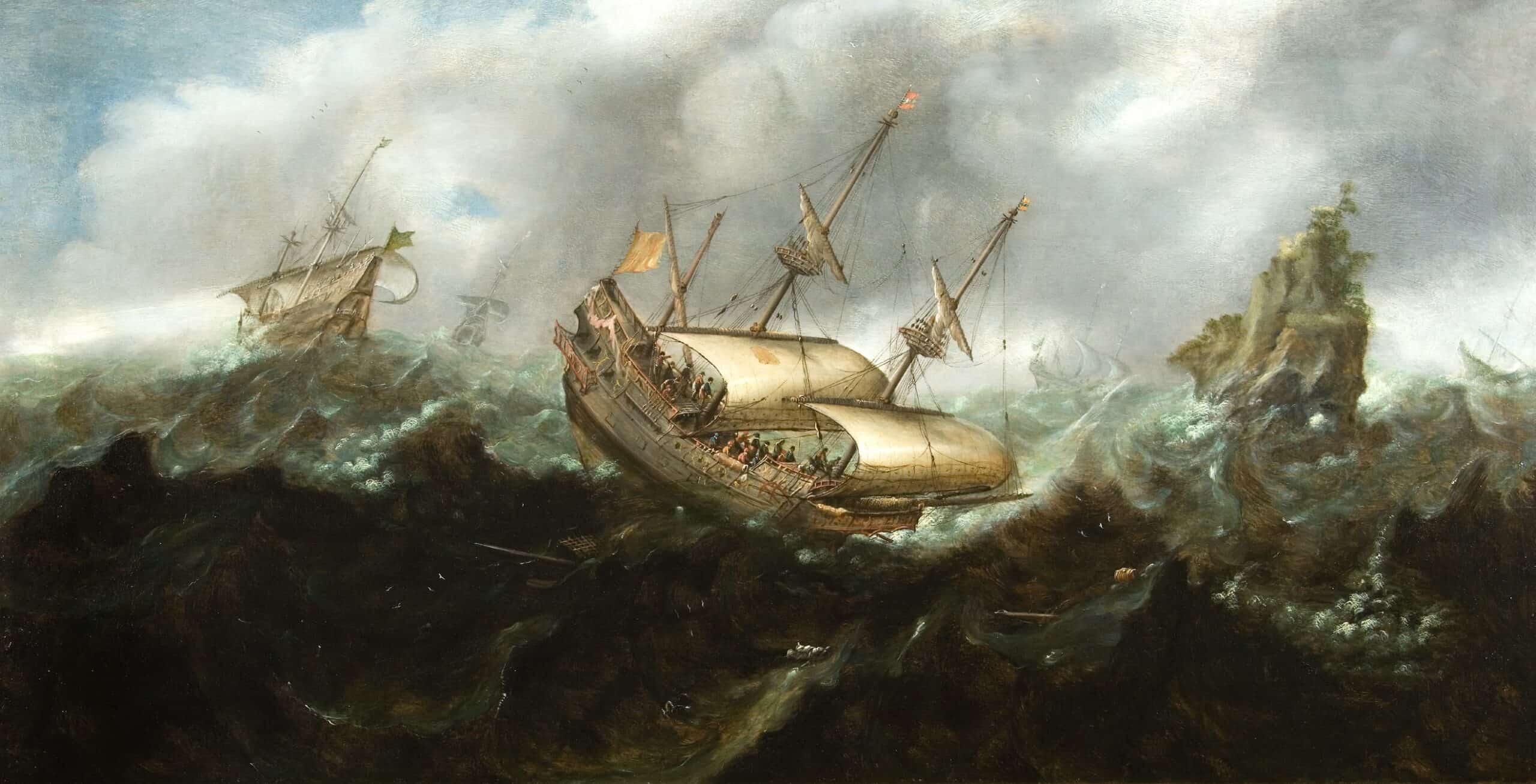
(Antwerp 1590 – 1652)
A storm on open seas
Oil on panel, 58.5 x 114.3 cm
Provenance: Dutch private collection
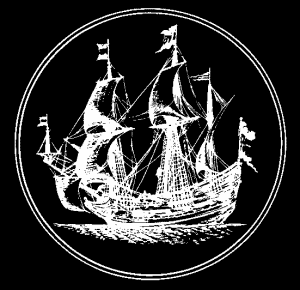
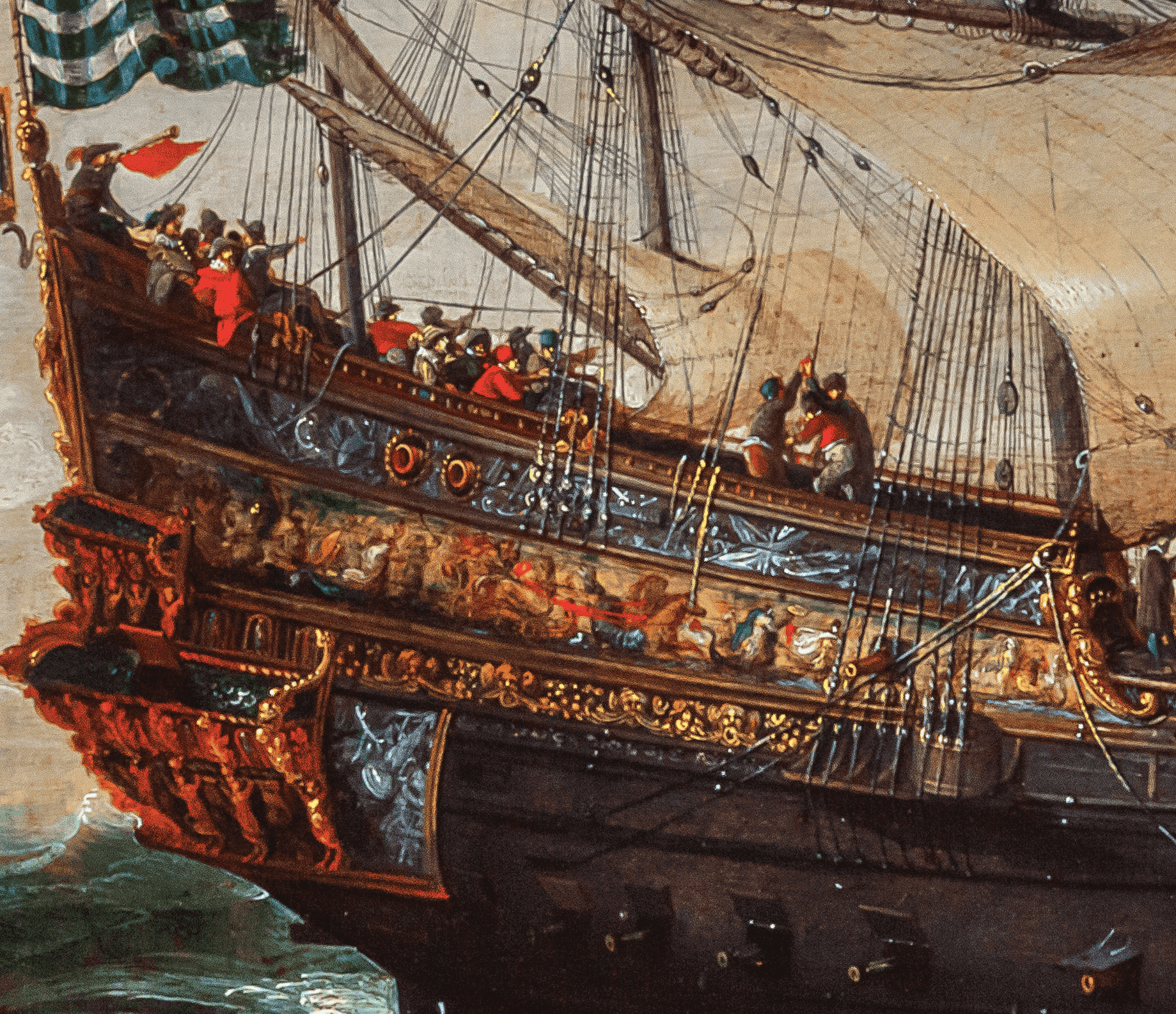
Oil on panel, 53.8 x 71.3 cm
PROVENANCE
– Anonymous sale, London, Phillips, 1849, lot unknown (according to the 1888 catalogue below);
– There purchased (‘through Mr Barker’) by Sir John Josiah Guest, 1st Bt., (1785–1852), Canford Manor, Dorset (bears the family bookplate on the reverse of the panel);
– By descent to Ivor Bertie Guest, 1st Baron Wimborne (1835– 1914), Canford Manor, Dorset;
– By descent to the Rt Hon. Ivor Guest, 1st Viscount Wimborne (1873–1939);
– By whom sold London, Christie’s, 9 March 1923, lot 57 (as Van de Velde) for 170 guineas to Asscher;
– G. Ribbius Pelletier, Utrecht, from 1941 until after 1952, by whom deposited (‘Bewaergeving’) at the Centraal Museum, Utrecht (according to a label on the reverse of the frame);
– Anonymous sale, Amsterdam, Mak van Waay, 12 May 1975, lot 284, (as Hendrik Cornelisz. Vroom), where acquired by Willem, Baron van Dedem
EXHIBITED
– Utrecht, Centraal Museum, on loan 1941–1952(?) (as Dutch School, mid-17th century), 1952 inv. no. 1186.
LITERATURE
– A Catalogue of the Pictures at Canford Manor in the Possession of Lord Wimborne, 1888, p. 101, no. 252 (as Willem van de Velde the Elder);
– M.E. Houtzager (ed.), Centraal Museum, Utrecht. Catalogus der schilderijen, Utrecht 1952, p. 403, no. 1186 (as Dutch school, mid-17th century);
– P.C. Sutton, Dutch & Flemish Paintings, The Collection of Willem Baron van Dedem, London 2002, pp. 96–99, no. 16, ill. (as Andries van Eertvelt, called Neantkens).
BIOGRAPHY
Andries van Eertvelt was born in 1590 in Antwerp, where he joined the Guild of St Luke as a master in 1609/10. He is generally seen as the first and one the most important Flemish marine painters of the seventeenth century. His work reflects the enduring influence of Pieter Bruegel the Elder. Although nothing is known of his apprenticeship, he is thought to have been trained in the northern Netherlands. There is a discernible Dutch influence in
Van Eertvelt’s work, which may have come from Hendrick Vroom (1566-1640), although Van Eertvelt need not necessarily have been Vroom’s pupil. He has the dramatic sense of the early work of Vroom, the ‘father’ of Dutch marine painting, particularly in his use of colours with a dominant green cast, which is the palette of the first generation of marine artists. Van Eertvelt also employs the same device of sea monsters in many of his paintings. He lived in Italy from 1628 to 1630, where he lodged with the painter and cultural attaché Cornelis de Wael in Genoa, who may also have been a formative influence.
Van Eertvelt’s seascapes, which exerted a lasting influence on marine painting in the southern Netherlands, exemplify the general tendency of Flemish painting towards more overt theatricality and rhetoric, distinguishing it from the relative restraint and unidealized directness of most Dutch art. Faithful rendering is subordinate to the spectacle in his decorative pieces.
Van Eertvelt specialized in the new subject matter of naval engagements, events, ships, and storms at sea. His work, with its busy,brightly coloured and dramatic style, was highly prized by his contemporaries. The strong brushwork is typical of Van Eertvelt’s stile furioso, which seems to derive from the work of Agostino Tassi and would be crucial for the development of the seventeenth-century Flemish marine.
It can be deduced from various sources that Van Eertvelt was held in high esteem. In 1632, after his return from Italy, Van Dyck
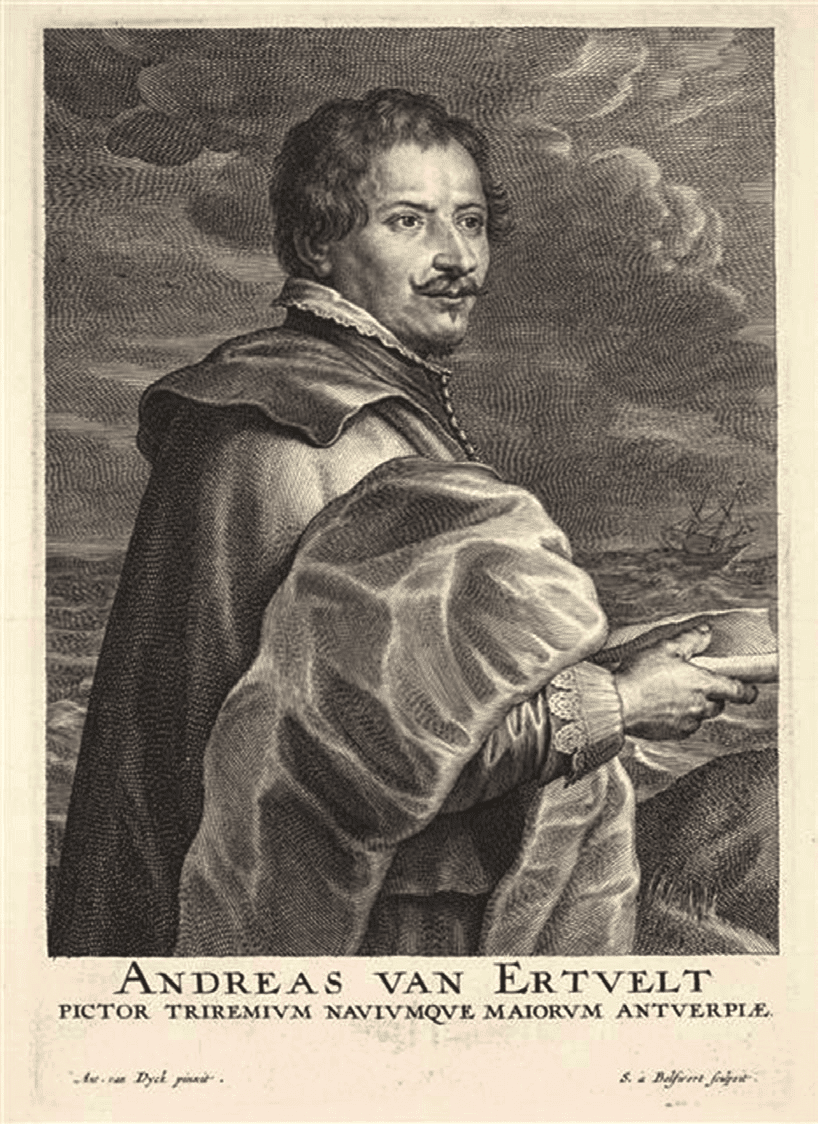
Schelte Adams Bolswert, portrait engraving Andries van
Eertvelt (after Anthony van Dyck), 212 x 166 mm
honoured him with a portrait in which he is seated at his easel painting a ship in distress, which can be seen through the window. His high reputation is further reflected in the celebration of his work in Cornelis de Bie’s Het Gulden Cabinet van de Edel Vry Schilderconst (The Golden Cabinet of the Noble, Free Art of Painting), published in 1662. He praised Van Eertvelt for painting his subjects ‘naer het leven’ (from life) and for using ‘selfs ghe inventeert’ (his own designs).
Some of Andries van Eertvelt’s works were exported to markets in Portugal, Spain and as far away as Neuva España. He also had an enthusiastic clientele in the Dutch Republic, and was one of the first Flemish marine painters to be active in Holland. His pupils reputedly included Hendrik van Minderhout, Matthieu van Plattenberg, Sebastian Castro and Gasper van Eyck. The latter frequently copied his tutor.
Van Eertvelt’s successful career continued after his return to Antwerp, and by the end of his life he was extremely wealthy. On 23 June 1649 he rented a house on the ‘Oever’ for the considerable sum of 240 florins per year. Three years later, at the beginning of August, Van Eertvelt died at the age of 62. Cornelis de Bie eulogized his work as ‘soo crachtich en soo soet/ Oft hy van jonghs af aen waer op Zee ghevoet’ (so powerful and so sweet, as if he had been at sea since his youth).
THE PAINTING
The Neptunus is viewed from the starboard quarter and is unusually large, for it has four masts, which was rare for Dutch seagoing vessels of this period. She is well armed, with all her gunports open, and is firing a salute on the port side. The ship is bustling with activity and is preparing to tack, for there is a freshening breeze and her sailors are busy with the sails on the fore and main masts. The array of flags on the vessels celebrates Dutch naval power, and in particular that of the province of Zeeland, with its flag displayed prominently at the stern of the Neptunus. Astern of her, another smaller man-of-war is already under way on the port tack. A few other ships are visible in the far distance, where the light seems to be brightening towards the horizon.
The composition is formulated with extraordinary accuracy and attention to detail, with intersecting diagonals. The Neptunus is depicted prominently in the middle, surrounded by the overall green of the waves gradually lightening towards the horizon, creating spatial depth. The palette is classic Andries van Eervelt, with the deep green-blue of the sea, its green waves crowned by thin white curly crests. The swirling white waves with their stylized crests are an indication that this is a relatively early work that was very probably painted before Van Eertvelt left for Italy in 1628. The crisp wave crests are painted in undulating lines of separate white brushstrokes and dots. The rendering of the waves appears to be based on first-hand experience of being at sea. The rigging and details of the ship are carefully executed. The figures and parts of the ships, such as the reefed sails, are highlighted by striking and sharp touches of white. Van Eertvelt adds more life and drama to the scene by contrasting the rich cream of the billowing sails, the warm hue of the ship’s timbers, the colourful scene of the god of the sea and his entourage on the stern, and the bright colours of the flags and the attire of the people on board.
THE SHIPS
This impressive four-masted man-of-war, the Neptunus, was one of the first of its kind. Due to changed political circumstances, the United Provinces needed larger warships if they were to fight Spanish ships on an equal footing and be evenly matched with the English ally. Larger vessels were also a necessity if the Republic wanted to carry out independent expeditions further from home. In order to expand its fleet as quickly as possible it turned to the English to buy large warships, as well as building their own. In the left of the painting there is a stern view of a smaller three-masted vessel flying the Dutch tricolour. This practice is illustrated by the English coat of arms on its taffrail.
A ship as a subject would also have had moral overtones for a seventeenth-century viewer. The ship as a symbol was open to several different interpretations, from the ‘Ship of State’ to the ‘Ship of Life’. Metaphorically, the spectator would be reminded that the safe stewardship of a ship demanded vigilance, wisdom, caution and prudence and, in case of the ‘Ship of Life’, God’s guidance.
THE NEPTUNUS
A scene of the god Neptune with his entourage is prominently displayed on the quarter gallery of the warship’s stern. On the broadside the god of the sea is in his triumphal chariot drawn by seahorses, hurtling along with goddesses, sea nymphs and other sea creatures. The scene is vivid, full of drama and ferocity. The virtues of the gods and goddesses would have been incorporated in representations in the ship itself. They would have included the figurehead of the immortal winged Pegasus on the bow, representing speed, strength and artistic inspiration. The decorative designs would placate the spirits of the sea, thus safeguarding the ship.
The stern ornamentation often indicated the name of a ship. The Admiralty of Zeeland had two four-masted men-of-war called Neptunus and not many were built, since their draught was too deep for the shallow waters around the Low Countries, which prevented deep-draught ships from manoeuvring freely. In the resolutions of the Admiralty of Zeeland, there is an account of the exchequer of 1593. The document states that Simon Ykens received a sum of 37 Flemish pounds for painting the Neptunus (ZA, Rekenkamer C, inv. no. 6150 fol. 35v) and received an advance payment (ZA, Rekenkamer C, inv.no. 36990 fol. 5).
In 1594 Van Campenhout made a statue of a Neptunus that was built in Veere, having the same name. Another Neptunus is mentioned in the resolutions of the Admiralty of Zeeland on 16 September 1613 and 1 September 1614, when Admiral Haultain reported extensively on the boarding-out of the ship’s wooden ornamentation. From this it can be deduced that this vessel was indeed the Neptunus, one of the above-mentioned ships. It is very likely that Van Eertvelt was commissioned to make this ship portrait to commemorate the four-master with its impressive ornamentation for present and future generations. There is no evidence he ever saw the ship in real life.
THE ARTISTIC DECORATION ON SHIPS
The tradition of ship ornamentation is a global practice dating back to prehistoric times. The design, structure and materials used in shipbuilding readily lent themselves to embellishment, with colour, elaborate carving and gold leaf enhancing an already beautiful shape. The decorations took the form of painted sails, hulls, flags, relief carving and signs and symbols on the bow and stern.
The wooden decorative work aboard a ship was where shipbuilding, architecture and art merged,from the late 1500s to the advent of steam and the introduction of steel ships. A ship came from the wharf devoid of ornamentation, save for its basic architecture. The ornamentation was a structural part of shipbuilding and there were generally accepted rules for its construction. The leading humanists and artists of the day were called upon to draw up the iconographic programme for the ship’s ornamentation and to ensure that the work was done according to the client’s instructions. The craftsman was to be replaced by the artist, and professional painters were asked to work on ship decoration, a fact that is much overlooked. The decoration of ships was an important branch of artistic activity in seafaring countries.
This practice of adorning naval vessels played an important role in the visualization of the power of the young Republic around 1600. The largest ships and those that were held in high esteem had more extensive decoration, with painted and carved figures and ornaments. Large warships were decorated to emphasize the military, political and sometimes ancestral power of a monarch and country, as these ships were often the only direct manifestation of a nation that was seen by its enemies.
The beautifully executed ornamentation on the Neptunus is a very rare and early example of this. The elaborately and extensively decorated ship, ornamented with carved and gilded embellishments, seems designed for a display of magnificence. The decoration is rendered so precisely in painting and in sculptural decorations that one could speak of a second work of art within the painting itself.
As with the stern ornamentation, the purpose of the figurehead was often to indicate the role or name of the ship, and always, in the case of naval ships, to demonstrate the wealth and might of the owner. The concept of ‘Magnificentia’ in the decoration of warships in the Dutch Republic was seen, as in the rest of Europe, as a means for a visual display of power.
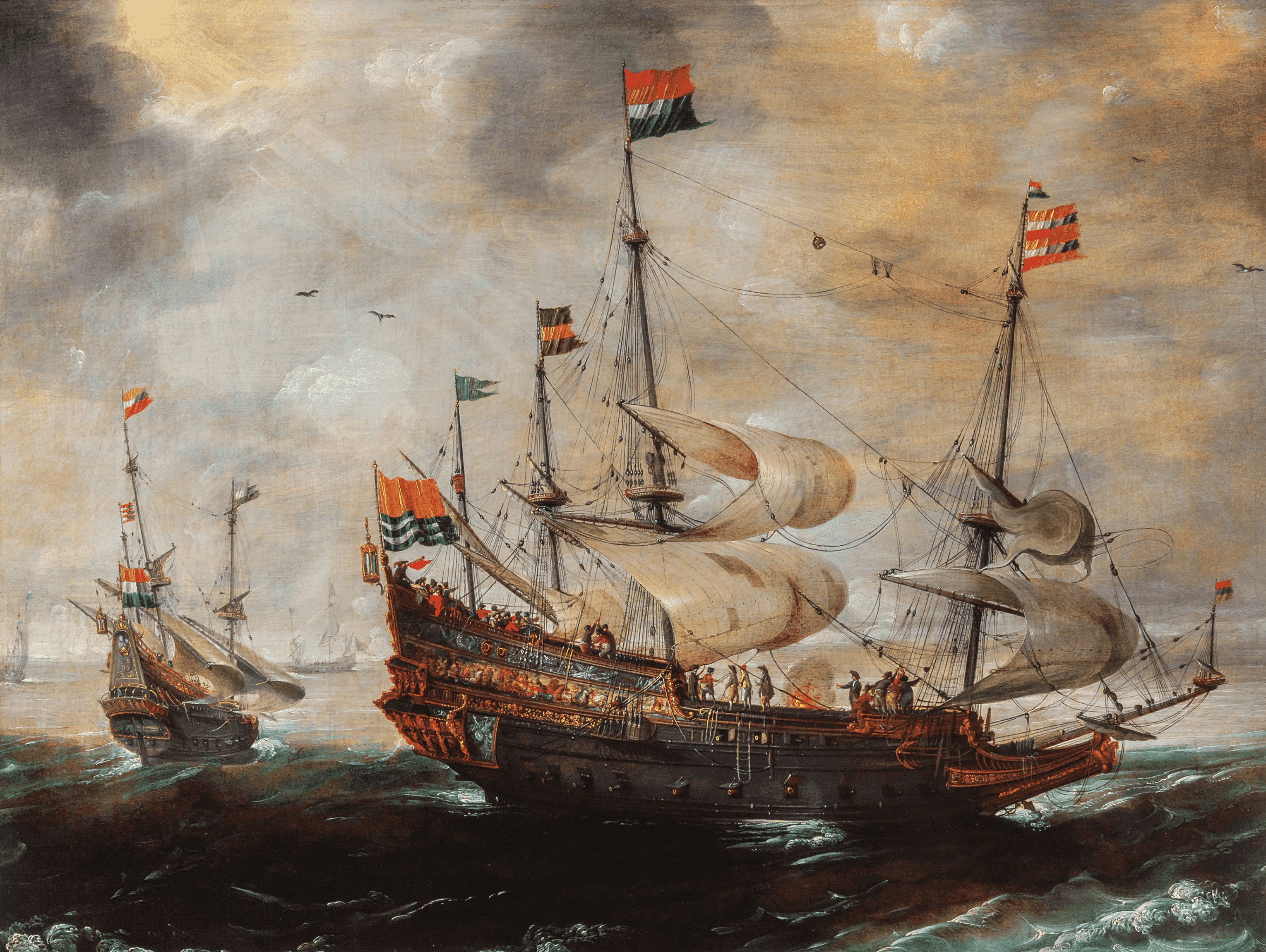
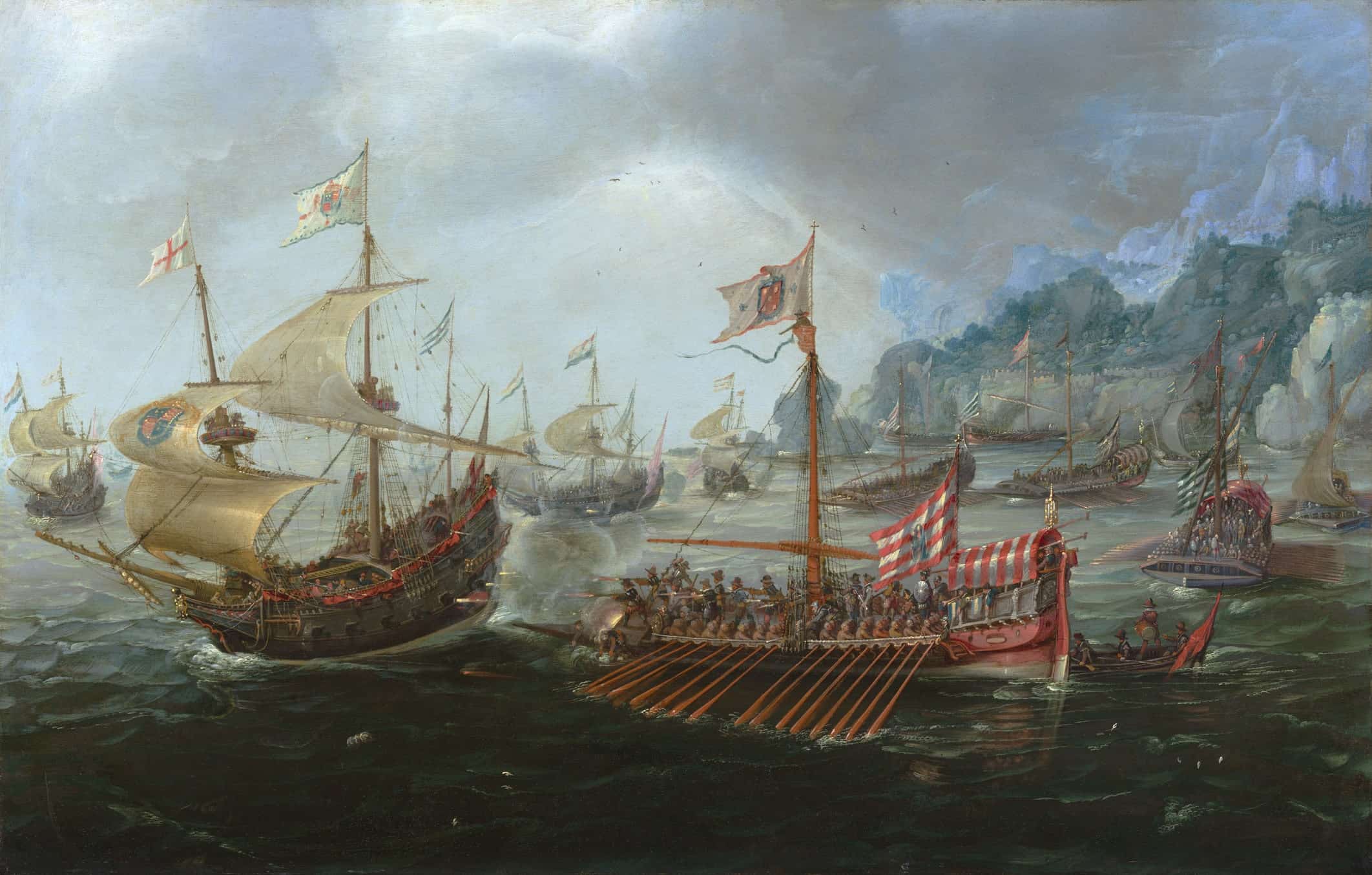
(Antwerp 1590 – 1652)
A battle between Spanish galleons and Dutch warships off a rugged coastline
Oil on copper 44 x 68.4 cm
Provenance: London, collection C. Turner; Bonn, collection Nell;
acquired by the grandfather of the present owner in the 1920s.
Gallery Rob Kattenburg | Eeuwigelaan 6 | 1861 CM Bergen (NH) | The Netherlands | Tel. +31 (0)72 589 50 51 | [email protected] | www.robkattenburg.nl |
© 2022 Rob Kattenburg
Website Mediya.nl